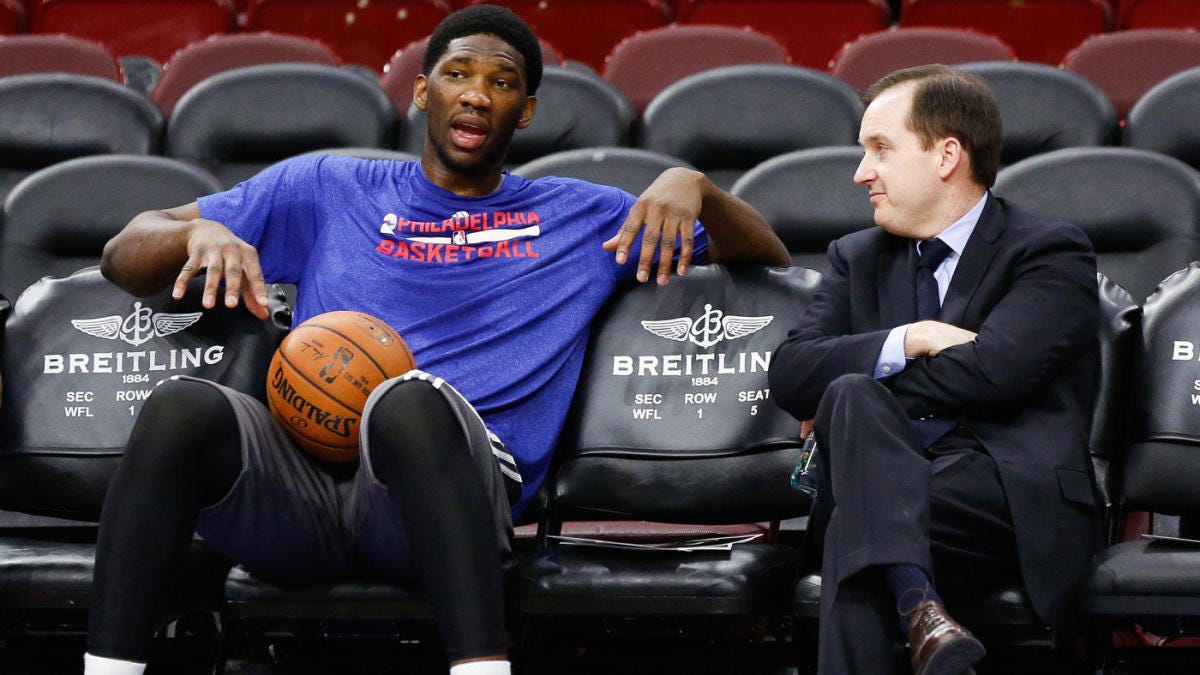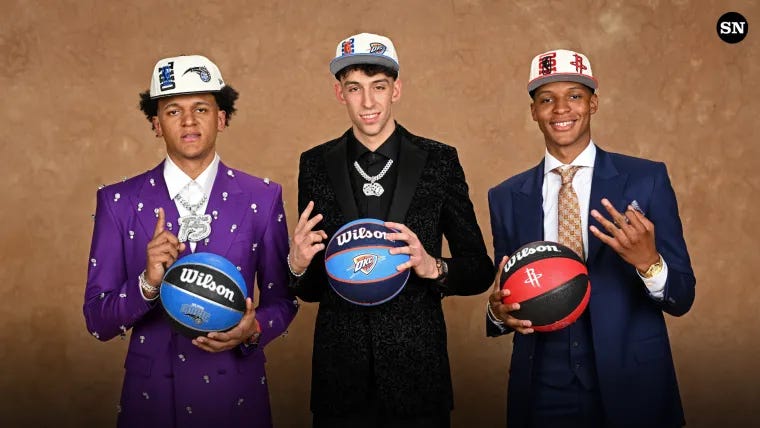The process has been laid out for teams to follow.
Gut your roster, accumulate young talent, give them the space to grow and develop, sign/acquire veteran players to help stimulate growth, and then pivot towards contention once your players make the strides needed to compete.
Philadelphia’s process started with Sam Hinkie and was personified by Joel Embiid, who rose to become an MVP-caliber player.
Sam Presti followed behind, benefitting from the supernova of their star-studded core and using the dust left behind to build one of the greatest treasure troves of draft capital we’ve ever seen.
Whether you agree with the process itself, the results are unquestionable. OKC’s championship proves that.
The closer to the top of the draft you sit, the higher your likelihood of landing a franchise-altering player. The more draft capital you sit on, the more lottery chances you have at finding the player to help you break through.
We’ve seen that process unfold and evolve alongside the modern NBA. Team constructions all have slight alterations, but the savviest, most well-run organizations have all prioritized one thing in common: prospects with size, feel, playmaking, and ballhandling, with skillsets geared towards thriving in a league where these traits are more important than ever.
The Orlando Magic are powered by two supersized playmakers who encapsulate what the modern NBA craves. The San Antonio Spurs are ready to make their move towards the top with arguably the most unique player the league has ever seen as their cornerstone. The Houston Rockets, who finished 2nd in the West in ‘24-25, join them, consolidating some of their assets into well-known superstar Kevin Durant, who they hope is the final piece of the puzzle. Oklahoma City won the NBA Championship, buoyed by their MVP in Shai Gilgeous-Alexander, with the second youngest roster in the league, and they still sit on a wealth of picks.
But who’s next?
To me, it’s the sleeping beasts of the East: The Washington Wizards.
I followed the team heavily last year as part of my rookie coverage and have completely fallen in love with the foundation they’ve built.
At first glance, that infatuation might not make sense.
They had (by far) the worst net-rating of any team in ‘24-25 at -12.5, with a bottom-5 defensive rating and the lowest offensive rating in the league.
But (trust me for a second), look past the record. Look past the analytics. Ignore the fact that 4 of the lowest +/- totals last season in the entire league lived in Washington.
And remember that sometimes, things that fail on paper pass the eye test, and, for watchful eyes, the young Wizards’ flashes of brilliance makes you wonder how high their ceiling might be.
They’re young. They’re tanking ethically. They’re throwing their young players into the deep end and letting them learn to swim, but also buoying them up by surrounding them with plenty of helpful veterans, who can teach them the proper techniques needed to stay afloat (Middleton, Smart, McCollum, Gill, Holmes, etc.).
Captained by Will Dawkins, who learned under (surprise surprise) Sam Presti, the Wizards’ ship has followed the MO of the teams that have come before and have wasted no time cleansing their roster, with only ONE player (Corey Kispert) remaining from the previous regime.
They’ve purposefully steered into this reset, and I love when a team fully commits one way or the other because having a direction is the first step towards every team’s final goal: building a contender with staying power.
And let’s remember one thing: they’re supposed to be bad. It’s a product of the process and that’s what a tank is: a hard reset designed to give your franchise an opportunity to build a solid foundation with multiple windows of contention.
When a team is driven by so much youth and inexperience, there will be countless bumps in the road; however, when things do click, you can’t help but be glued to the screen.
The offense flows. The kids are unselfish. They create open looks and play within the system, but in a way that allows their individual gifts to shine too (Sarr’s fludidity in the open court & natural playmaking, George’s connective ballhandling and passing, Carrington’s ability to operate off-ball or go to work in the mid-range, and more).
They have plus positional size. They all have great feel as ballhandlers and playmakers. They can run position-less line ups where the offense can be initiated by anyone on the court. The ball moves fluidly, with everyone capable of running a fast break or putting the ball onto the court and driving to the rim.
The flashes of brilliance aren’t just limited to their offense. Yes, the defense, by the numbers, are atrocious, to put it plainly. But they’ve got defensive weapons all over the roster, even if they are weapons that clearly need honing.
With Alex Sarr, Bilal Coulibaly, and Kyshawn George at the forefront, the young Wizards have shown they have the tools needed to not just hang, but dominate defensively. In fact, after the all-star break, Kyshawn held his assignments to a cumulative FG% of 40% (5.9% below expected), which was the lowest DFG% among player with 300+ field goals defended.
The defensive flashes weren’t just limited to Sarr, Kyshawn, and Bilal, and that’s a feature, not a bug. Because of Dawkins’ drafting style, every player they’ve acquired can guard multiple positions.
So far, their prospects consist of:
Alex Sarr, 20 - 6’11.75” (2nd Overall pick in ‘24)
Will Riley, 19 - 6’8.25” (21st Overall Pick in ‘25)
Bilal Coulibaly, 20 - 6’8” (7th Overall Pick in ‘23)
Kyshawn George, 21 - 6’7” (24th Overall Pick in ‘24)
Jamir Watkins, 23 - 6’5” (43rd Overall Pick in ‘24)
Tre Johnson, 19 - 6’4.75” (6th Overall Pick in ‘25)
AJ Johnson, 20 - 6’4.25” (23rd Overall Pick in ‘24)
Bub Carrington, 19 - 6’3.75” (14th Overall Pick in ‘24)
As you can see, they all fit the theme. Positionally long. Natural Playmakers. Defensively Versatile. High-Feel across every position. Like OKC did before them, they’ve found a direction, built a system, and are aggressively targeting players that satisfy the criteria they have.
That’s how a great team is built: with patience, direction, and a little bit of luck.
But when you build something with a strong foundation, it lasts.
Dawkins and Washington’s process goes beyond the players. They’ve not only accumulated promising prospects, but they’re consistently stacking up future draft capital while also maintaining maximum flexibility going forward.
After trading away Jordan Poole for McCollum, they’re poised to have around $100 million in cap space after the ‘25-26 season, giving them space to add key vets, like OKC did with Hartenstein or Houston with Fred Van Vleet and Dillon Brooks that they can use to complement their core and hopefully one of the budding stars in the ‘26 Draft Class.
They’re still a few years away and there’s plenty of growth left to go. The process is still loading, but, as we’ve seen with OKC, Orlando, San Antonio, and Houston, the final product is worth the wait.
Like Will Dawkins said, Washington has their eyes on the playoffs, but they don’t just want to appear.
They want to arrive.






